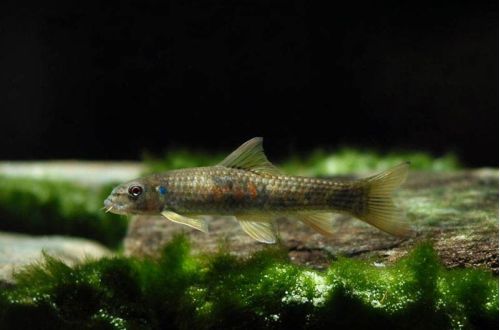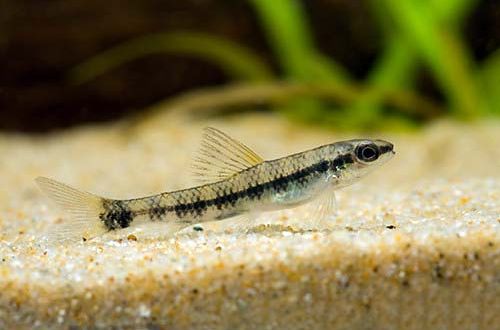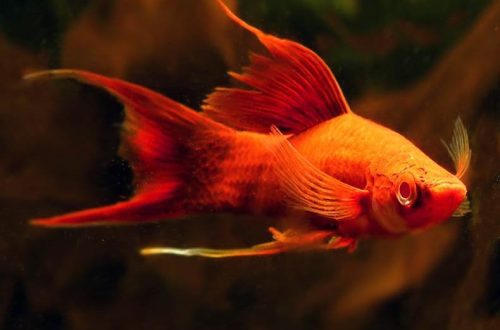
Garra Rufa
Garra Rufa or Doctor Fish, scientific name Garra rufa, belongs to the Cyprinidae family. It is considered one of the most famous fish. True, it is by no means popular in home aquariums, but in the area at the intersection of medicine and cosmetology. This species is widely used in resorts and sanatoriums for the symptomatic treatment of psoriasis.

Contents
Habitat
Fish come from Central Asia from Turkey, Syria, Iraq and Iran. It occurs everywhere, from rivers with clear water and fast currents, to shallow, muddy periodically drying up reservoirs.
Due to active fishing in its natural habitat, it is on the verge of extinction.
Brief information:
- The volume of the aquarium – from 250 liters.
- Temperature – 14-20°C
- Value pH — 6.0–8.0
- Water hardness – 0–25 dGH
- Substrate type — stony
- Lighting – bright
- Brackish water – no
- Water movement – moderate or strong
- The size of the fish is 10–12 cm.
- Nutrition – any food with a high content of plant components
- Temperament – peaceful
- Keeping in a group of 3-4 individuals
Description
The active use of this fish to relieve the symptoms of psoriasis has led to several closely related species being sold under the name Garra Rufa, as well as many hybrids resulting from them.
True Garra rufa reaches a length of 10–12 cm. The color is dark gray heterogeneous. Juveniles have a conspicuous blue spot behind the gill cover. The tips of the dorsal fin and tail have black marks. Near the mouth are two pairs of small antennae.
Sexual dimorphism is weakly expressed. The females are somewhat larger. Males, respectively, are somewhat slimmer, and small tubercles appear on their heads during the mating season.
Food
In nature, it feeds on the so-called “biofilm” that forms on the surface of flooded snags and stones. “Biofilm” is a layer of algae and small invertebrates inhabiting it (worms, crustaceans, larvae, etc.).
In a home aquarium, the daily diet should consist of protein and vegetable products, or a combination of both in one food. Can accept dry sinking food, pieces of cucumber, zucchini, blanched spinach and similar green vegetables.
Maintenance and care, arrangement of the aquarium
Looking at the fish during their “medical procedures” you might think that they can be content with an empty tank filled with water. However, such an environment is by no means optimal.
Garra Rufa is recommended to be kept in spacious aquariums with a volume of 250 liters or more (for 3-4 fish) decorated with driftwood and stones interspersed with sand as a substrate. Aquatic vegetation is not required. If desired, you can use plants that can grow on wood and stone surfaces without immersion in the ground.
Water quality is of key importance, while hydrochemical indicators are not so important. The fish are able to adapt to a wide range of pH and dGH values. It is important to provide clean running water rich in oxygen and recreate moderate flow conditions.
Behavior and Compatibility
Peaceful friendly fish. Prefers to be in a group, one by one can become aggressive. Compatible with other calm species of comparable size.
Breeding / breeding
In nature, breeding is not regular and usually occurs from April to November after prolonged rainfall. Fish scatter eggs along the bottom and do not show parental care for offspring. Different sources provide sometimes conflicting information about the features of breeding these fish in an artificial environment. In any case, it is necessary to recreate a change in external conditions that simulate heavy rains, as well as provide a high-protein diet.
Fish diseases
In favorable conditions, cases of the disease are rare. Deterioration of the habitat, poor quality food, contact with already sick fish, frames can provoke the manifestation of the disease. In most cases, if the causes are eliminated, and if there has not been prolonged exposure, the immune system will be able to cope with the ailments. Otherwise, medical treatment will be required. Read more about symptoms and treatments in the Aquarium Fish Diseases section.





